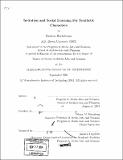Imitation and social learning for synthetic characters
Author(s)
Buchsbaum, Daphna, 1979-
DownloadFull printable version (17.11Mb)
Other Contributors
Massachusetts Institute of Technology. Dept. of Architecture. Program in Media Arts and Sciences.
Advisor
Bruce M. Blumberg.
Terms of use
Metadata
Show full item recordAbstract
We want to build animated characters and robots capable of rich social interactions with humans and each other, and who are able to learn by observing those around them. An increasing amount of evidence suggests that, in human infants, the ability to learn by watching others, and in particular, the ability to imitate, could be crucial precursors to the development of appropriate social behavior, and ultimately the ability to reason about the thoughts, intents, beliefs, and desires of others. We have created a number of imitative characters and robots, the latest of which is Max T. Mouse, an anthropomorphic animated mouse character who is able to observe the actions he sees his friend Morris Mouse performing, and compare them to the actions he knows how to perform himself. This matching process allows Max to accurately imitate Morris's gestures and actions, even when provided with limited synthetic visual input. Furthermore, by using his own perception, motor, and action systems as models for the behavioral and perceptual capabilities of others (a process known as Simulation Theory in the cognitive literature), Max can begin to identify simple goals and motivations for Morris's behavior, an important step towards developing characters with a full theory of mind. Finally, Max can learn about unfamiliar objects in his environment, such as food and toys, by observing and correctly interpreting Morris's interactions with these objects, demonstrating his ability to take advantage of socially acquired information.
Description
Thesis (S.M.)--Massachusetts Institute of Technology, School of Architecture and Planning, Program in Media Arts and Sciences, 2004. Includes bibliographical references (p. 137-149).
Date issued
2004Department
Program in Media Arts and Sciences (Massachusetts Institute of Technology)Publisher
Massachusetts Institute of Technology
Keywords
Architecture. Program in Media Arts and Sciences.